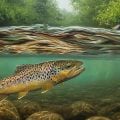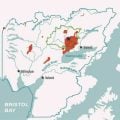How To: Fly Fishing for Keys Barracuda

Frankie Marion/C1 Films photo
In the last five years, the list of species we regularly target on fly in the Keys has grown to include the barracuda. I’m not sure exactly when it happened—like most things, it probably happened bit by bit over time. When Justin and Loren Rea started the Cuda Bowl in 2011, there were more than a few people that thought that the barracuda were too weak a target to build a tournament around. The first year there were 13 boats, as I recall. The winner got a bar tab at Hurricane Hole marina, and someone may have gotten into some trouble on the drive home. It was a fun tournament designed to get some guides busy in the off season, but the interest started out higher than was anticipated and grew steadily. When I first fished the tournament, I was pretty sure we would do well. I had fished for barracuda before, and never had much trouble feeding them. How hard would it be to make things happen in the tournament?
My ego got a good talking to when we were thrashed on the first day by Scott Irvine fishing with Bill Stockton. The next year, I fished it again. It was blowing 30, and I caught a fish on the first day. No one else in the fly division had caught one, and going in to the second day I was sure we were going to win. We caught a monster on the second day, but couldn’t get the other two that we needed to fill out our scorecard (the Cuda Bowl scoring format gives points for your three biggest fish per day). At the dock we discovered that we were in second place again—Scott Irvine had beaten us again, this time as a guide. His angler Trent Miller had caught three smaller fish to shoulder us into second place.
After the second tough loss we started to retool our approach. We made changes to our rigging and terminal tackle that started to make a difference. We messed with flies, placement, and retrieve. While barracuda used to be something we only targeted when the conditions were perfect, the tournament had made it clear that we needed to find a way to catch barracuda under any conditions that two random winter days could produce. We also needed to make sure they were big. Until we started working at it, the barracuda we caught were always the little ones—under 35 inches. Every so often we’d catch a 40+, but this was the exception and not something we could count on. We set our sights on figuring out a way to make the larger barracuda fish we could catch consistently on fly in nearly any conditions.
Here’s what we learned, in no particular order. I’ll make it a point here to point out that these tactics are probably necessary only when you’re fishing the Keys. Between the commercial and recreational pressure, our fish have become difficult in a way that they haven’t in other places. But with the following tweaks a winter day (any winter day) can produce more bites than we ever thought possible, and from fish bigger than we used to hope for with a fly rod.

Frankie Marion/C1 Films photo
Flies
A barracuda fly needs to handle lots of casts without fouling, and it needs a stinger hook. I hook probably 95% of the fish I catch on the trailing hook, and those that are hooked with the front hook are also often stuck on the rear hook. If it were up to me, I’d never throw a fly without a stinger hook at a barracuda. I’ve also learned to shy away from flies that have hair bodies. The hair can wrap around the rear hook and keep it from tracking straight.
The fly we started using was an Umpqua tie, and it was a great pattern. It was a needlefish fly, and it had two hooks. It came in one color: chartreuse. The pattern was awesome, but the hardware was garbage. The rear hook was made of tin, and I could bend it open with my thumbs without trying very hard. Barracuda have a strong bite, and they could (and would) open the rear hook with zero drag pressure. The rear hook was attached with nylon coated braided wire, which was passed through the eye of the rear hook and simply melted to itself. I’m not trying to sell Umpqua up the river here but it’s part of the story and I can’t not bring it up. They’ve since re-specified the hooks on the fly, and I think the fly is now well constructed with a better connection and a SP11 3H in the back. Whatever fly you choose to throw at barracuda, make sure that you’ve got premium hooks and a connection that will withstand teeth and pressure from either direction.
| If you’re planning a trip to Key West for Florida’s Lower Keys, be sure to stop in at The Angling Company at 333 Simonton Street in Key West (phone: (305) 292-6306). They have a full selection of the top brands in saltwater gear and can help you find an excellent guide. |
The things we liked about the fly was the fact that it was light, easy to cast and didn’t foul. This was huge, especially when we started to cover some water instead of waiting for a shot. The fly had Mylar tubing over the body, so there was nothing to wrap around the back hook. I worked with Dave Skok, a friend of mine who ties all the flies for my shop, and together we re-designed the Umpqua fly and called it the Waterwolf Special. Whatever fly you decide to use, make sure it won’t foul and that you can cast it far. The other thing we learned was to have an array of colors. When we first started out trying to catch these big barracuda, we always threw chartreuse. This worked fine most of the time, but having some “Specials” in pearl when it was clear, and black when it was overcast or the water was off-color, was a logical next step. Now we carry chartreuse, olive, pearl, black and pink when we’re fishing and we find that each of these colors has its day. Our Specials nowadays have a 2/0 SC15 in the back, and a 3/0 in the front.
Covering Water
One of the things we noticed during the Cuda Bowl was that the spin guys put up some serious numbers in the wind and clouds. Where we would catch a fish if we were lucky, these guys were catching double-digit numbers of fish, many of which were north of the magic 40-inch mark. I didn’t really understand the value of covering water until a few years ago, when John Benvenuto and I were fishing in the rain and wind on day one of the tournament. We knew there were fish around, but there was no possible way to see them. I put my mind to covering water and caught two fish over 40 inches in an hour. Covering water isn’t something you have to do all day, but a cast every now and then over a depth change, a white spot, or where you see some bait flip can deliver amazing results if you try it. The best part about covering water is that when it’s windy you can do it easily—just make sure you’re casting down or cross wind and let the breeze do the work for you.
Clear Lines
Barracuda are nothing if not aware of their surroundings, and if you cast an opaque line over (or near) a fish you’ll lose a lot of opportunities. Even when we were sight fishing, we found that a clear line is of the utmost importance when fly fishing for barracuda. I remember Aaron Snell, a good friend of mine and fantastic fishing guide, telling me about the first time he threw a clear line. According to him, the barracuda didn’t even move when he threw the line right next to them. A barracuda is on the flats looking for food, and they’re ambush predators. They park and stare, waiting for a hapless needle fish or ballyhoo to cross in front of them before they give chase and cut it in half. They can see things that are 20 feet away from them easily, so if you’re throwing a 12-foot leader on an opaque line you’re already showing your hand when you present the fly. Airflo makes a 105-foot clear tip floating line, which is an easy line to throw and has a 30-foot section of clear at its end. (Monic also makes a popular clear line.) Add a 15-foot leader, and you’ve got 45 feet of clear line to mask your fly line. Without a clear line, I would estimate we’d catch less than 50% of the fish we do with it—especially if you make it a habit to cover water now and then.

Frankie Marion/C1 Films photo
Leader
I like to keep it simple for barracuda. I tie a 12-foot butt section of 60# fluorocarbon to the end of my clear tip line, and then attach three feet of 16# or 20# Mason hard monofilament with an improved blood knot. I double the monofilament and tie a 4-turn Albright knot to some #5 (44 lb) wire, which I leave at a foot to keep things IGFA legal. There isn’t a barracuda that swims that you can’t catch on 20#, and if you’re looking for me to cosign the “I’m not fishing for records, who cares?” rhetoric you’re in the wrong place. Learn how to tie a proper leader and move on. Even if you have no interest in records, doing things the right way teaches you all kind of things. Once you learn how to rig properly it takes less time and is stronger than fishing 30 pound “class.” Once a fly is trashed you can cut it off and re-tie another on the same wire, recycling your bite tippet without losing more than an inch. When I’m barracuda fishing I pre-tie a bunch of class tippets with the wire already attached. When I want to change I simply cut the old one off, tie the class to my butt section, and haywire on my fly.
Retrieve: 30-60-90
This is probably the most important thing in barracuda fishing. If there’s a secret that we’ve stumbled across, it’s this: you can’t move a fly fast enough. The spin fisherman can get a tube going at Mach 4 in no time, and with today’s ultra-high ratio spinning reels it’s easier than ever. The issue that we used to have was that we would get the fly in play and start moving it as fast as we could, trying to imitate what the spin guys were doing. Our results suffered. Fish would follow but inevitably fall out of love before they made a commitment, and we were left to figure out another way to do things. John O’Hearn was the one that first mentioned starting slow, then accelerating the fly. John Benvenuto and I further refined John’s ideas by coming up with what we called “30-60-90.” Basically, start out at 30% of what you think is your maximum speed. If the fish is on it, turn it up to 60%. If you don’t get a bite, move to 90% of your max. Each time the fly accelerates, the fish will get closer and try to bite it. Once you’re at 90%, you can maintain the speed, and even speed it up a little to force a bite. But if you ever start moving the fly as fast as you can, remember: it’s all downhill from there. The fish will hardly ever bite a fly that’s slowing down, so you have to keep the speed on the rise. This means starting slow. The fish biting when the fly speeds up happens all the time, and that’s worth keeping in mind when you’re covering water. Nearly every bite I’ve gotten when I’m blind casting happens when I speed up the fly. I’ll watch the fly in overcast conditions sometimes, keeping my retrieve at about 30%, and I’ll only speed it up right at the end of the retrieve, or if I see some disturbance behind the fly. This way I’m not killing myself by stripping the fly fast every time. I will mention again that the single biggest thing is that the fly is increasing the speed the whole time—anything else, and you’ll be struggling to get those teeth to crack open.
Fly Placement
The placement of the fly is crucial. I want the barracuda to feel as though they are seeing this thing for the first time when it’s already in the water. A lot of anglers fish barracuda too close. The fish in the Keys are clever and well-educated, and you will rarely get away with dropping the fly on their nose. I try to throw the fly between 5 and 15 feet in front of the fish, depending on water clarity and sunlight. The calmer and clearer the conditions, the farther in front (and past) the fish I’ll throw. If conditions are overcast and the water rough or off-color, I’ll tighten things up, throwing closer to the fish and not so far past it. A good rule to bear in mind is to cross the fish (throw past its line) by the same distance that you throw in front of it. If I present a fly 20 feet in front of a fish, I’ll throw 20 feet past it as well. If I throw a fly 10 feet in front of a fish, I’ll throw it 10 feet past it—you get the idea. I want the fly to be swimming at 30% speed when they notice it. Once they see it they’ll curl around and follow, or sometimes just kick after it and bite. If they bite you’re good to go, but if they curl and follow just remember to increase the speed to force the error.
Another important issue to discuss when talking about fly placement for barracuda is the overall distance at which you’re presenting the fly. Since barracuda are aware of their surroundings, they will often notice the boat if you’re too close. They pay attention to things out of the water, and more than I’d like to I’ve seen fish start to turn away from us as we’re getting in to position. The best cast to one of these fish is the longest you can make. The fish will be less aware of the boat’s location, and you’ll get better reactions. You’ll also have the space to make your 30-60-90 happen in—one thing you don’t want to do when a 50-inch fish is about to eat the fly is run out of real estate.
All of the above are things we’ve learned in the last five years, and each one of them has been the result of input from a lot of people. The guys that I fish with and am friends with have worked to make all this stuff part of our fishing. The best piece of advice I can give you is to book a good guide and let them talk to you through it.
This year, the Cuda Bowl had its sixth year. It was attended by some of the best tournament guides in the Keys—Dustin Huff, Aaron Snell, Scott Collins, Justin Rea, Drew Delashmit, John O’Hearn, Doug Kilatrick, Bobby Paulson, John Benvenuto, Pat Bracher—and was capped at 40 teams vying for victory in both fly and spin divisions. Also, the barracuda received protection for the first time a few months before the tournament, when FWC passed measures to reduce the commercial and recreational harvest to two per angler per day. We are in the middle of perhaps one of the largest concentrations of trophy-sized barracuda in the world, and we’re learning every day how to catch (and release) them more effectively.
To see some of the action that barracuda can deliver, check out Frankie Marion’s recently produced barracuda-on-fly film, “Waterwolf.”











